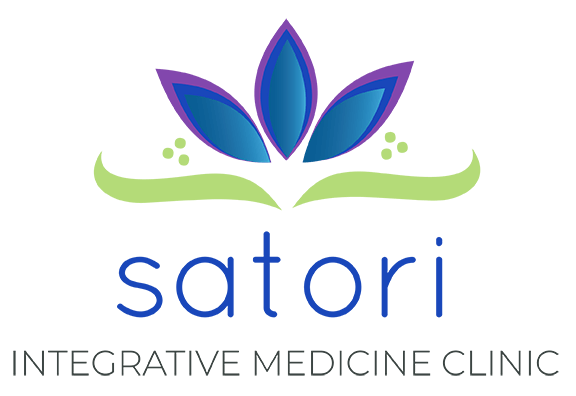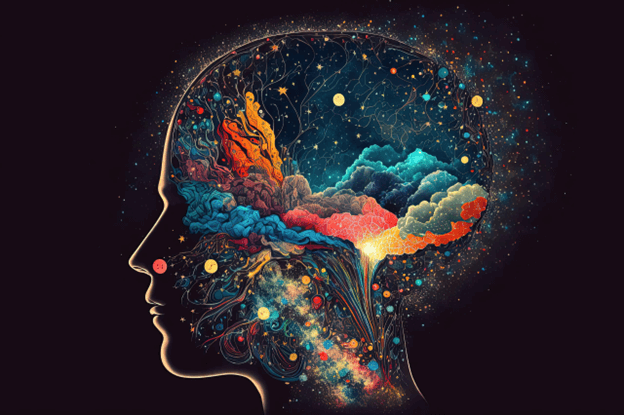Psychedelic-assisted therapy (PAT) is an emerging field that has gained attention for its potential to treat various mental health conditions, such as PTSD, depression, and anxiety. However, despite promising results, there are still misconceptions and stigmas surrounding this type of therapy.
We wanted to shine some light on this topic with some content around:
- a “definition” of psychedelic-assisted therapy
- common misinterpretations about PAT
- benefits of PAT (looking at ketamine specifically)
Our intention is to share information and address mistaken beliefs to foster a better understanding of the therapy’s true potential. That said, one of the reasons we are so committed to this modality is that there is so much good evidence from well-known institutions (such as Harvard, Johns Hopkins, Stanford) about the efficacy of this modality.
What is Psychedelic Assisted Therapy?
Psychology Today describes psychedelic-assisted therapy (PAT) as a unique “marriage” of psychedelic drugs and psychotherapy administered in a professionally monitored environment to create rapid and long-lasting psychological and behavioral change in people suffering from persistent disorders, such as PTSD. PAT involves psychotherapy individually tailored to a patient’s experience upon receiving a pharmaceutical-grade psychedelic drug in a medically safe way.
It’s important to consider that the psychedelics are not all alike. Which agent might work best for an individual depends on many factors: personal / family history, current medications, goals for treatment, previous experience with psychedelics, availability of knowledgeable providers, geography and/or ability to travel since some of these medications are only available in certain locations. Speaking with a practitioner who knows the entire field of options and isn’t focused on just one path is essential to finding the right practitioner for you. At Satori Integrative Medicine Clinic, while we provide ketamine infusions in our clinic, we also have a good understanding of the risk / benefit profile of many other substances and can help individuals through the process of choosing a treatment that best fits their circumstances. For example, we have counseled patients who want to do therapy using psilocybin under the pathway recently legislated in Colorado. We have also recommended that other patients not use psychedelics at all due to family and personal history. A qualified practitioner will recognize that all patients have unique needs and some psychedelics work better in some situations than others. They will work with you to develop an appropriate treatment plan.
Finally, it’s vital to recognize the full import of the psychotherapy component of PAT. Patients who receive the greatest benefits are those who are working with their therapist before, during and after their course of psychedelic treatments.
Misconceptions About Psychedelic Assisted Therapy
1. Psychedelic Therapy is Just About Getting High
One of the most prevalent misconceptions is that psychedelic-assisted therapy is simply about using substances to experience a “trip” or get high. In reality, the psychedelics used in therapy, such as psilocybin, MDMA, or LSD, are administered in a controlled, clinical setting with a licensed therapist guiding the process. The goal isn’t recreational use but rather to facilitate emotional breakthroughs, self-reflection, and healing. The therapeutic setting ensures safety, structure, and proper integration of the experience into the patient’s healing journey.
2. Psychedelics Are Addictive
Another common misconception is that psychedelic substances are addictive. Research shows that most psychedelics (like psilocybin, MDMA, and LSD) are non-addictive. These substances do not lead to dependency or withdrawal symptoms like substances such as alcohol or opioids. Instead, they work by temporarily altering the way the brain processes information, potentially allowing individuals to confront deep-seated issues without the need for ongoing use.
3. Psychedelic Therapy is Only for People Who Are ‘Broken’
There’s a misconception that psychedelic therapy is only for individuals with severe mental health conditions, such as those with chronic depression, PTSD, or addiction. In truth, psychedelic-assisted therapy can also benefit individuals who are seeking personal growth, self-awareness, or relief from general life stress. It’s not just about healing “broken” people; it’s about providing an opportunity for individuals to explore their consciousness and gain deeper insights into their emotional lives.
4. Psychedelic Therapy is Dangerous and Unregulated
Many people are concerned about the safety of psychedelic therapy due to the unregulated nature of the substances in the past. While it’s true that psychedelics were largely banned for decades, clinical research has shown that, when administered in a controlled, therapeutic setting with trained professionals, these substances are safe. The therapeutic process includes extensive screening, monitoring, and integration support to ensure patient safety and effectiveness. Moreover, with the increasing number of clinical trials and FDA-approved research studies, the legitimacy and safety of psychedelic therapy is becoming more evident. Carefully choosing a qualified provider is the key to both safety and a good experience.
5. Psychedelic Therapy is a Quick Fix
There’s an assumption that psychedelic therapy is a quick, one-time solution to mental health struggles. While the experience of a psychedelic session may be intense and profound, true healing takes time. Depending on the type of therapy and the person’s goals, multiple sessions may be necessary. Effectiveness of treatment is significantly enhanced by ongoing psychotherapy and integration sessions after the psychedelic experience. It’s the process, not just a one-time experience, that encourages long-term growth and change.
6. You Need to Have a ‘Spiritual’ Experience for It to Work
There’s an assumption that psychedelic therapy requires individuals to have a “spiritual” or “transcendental” experience to be effective. While some people do report having profound spiritual experiences, others may have more psychological or emotional breakthroughs. The goals of therapy, the individual’s health history, and the set and setting of treatment should determine dosing strategy and the appropriate depth of the experience. For example, a psycholytic dose is a low to medium dose of medication that allows for psychotherapy during the session. The effectiveness of psychedelic therapy is not necessarily dependent on having a particular type of experience but rather on the ability to integrate the insights gained during the session into one’s life.
7. Psychedelic Therapy Is Just a Trend
With the rise of interest in psychedelic therapy, some people view it as a passing trend or fad. use of psychedelics in healing and mental health treatment is grounded in a long history, dating back to indigenous cultures that used plant medicine for healing purposes. The renewed interest in psychedelic therapy is not just a trend but the result of rigorous scientific research and clinical trials demonstrating its potential.
***
So, those are some of the misconceptions.
What about the benefits?
Benefits of Psychedelic Treatment
Rapid Results
Psychedelic Assisted Therapy has demonstrated certain benefits over other therapy alone or other types of medications. Unlike conventional antidepressants, which can take weeks to show effects, these substances generally work within hours, providing rapid relief. This makes it a potential game-changer for those with severe mental (or physical) health conditions. As one of our ketamine patients put it after their first session: “I’ve done a lot of therapy – this is like 10 years of therapy on steroids, in an hour.”
Wide Range
Psychedelic Assisted Therapy is effective in treating a wide range of conditions: major depression, bipolar disorder (bipolar depression), postpartum depression, anxiety, post-traumatic stress disorder (PTSD), obsessive compulsive disorder (OCD), some pain syndromes and addiction. For depression specifically, ketamine therapy is one of the most effective major depressive disorder treatments, alleviating symptoms for up to 80% of patients…even in those with treatment resistant depression.
Changes the Brain
Psychedelic Assisted Therapy is thought to work by promoting synaptic plasticity (blog) and enhancing brain connectivity. It changes the way brain works, rather than just treating symptoms. Side effects are generally mild and short-lived. Furthermore, psychedelic medicines are not generally addictive, especially when they are administered under clinical supervision. Ketamine has been studied more extensively than other psychedelics. This research has changed the way we understand the brain and how we can use PAT to revolutionize mental health treatment.
Why do we use Ketamine at Satori Integrative Medicine?
Ketamine has some advantages over other psychedelics in clinical use.
Decades of Clinical Experience
Developed in the 1960s and FDA approved for clinical use since 1970, ketamine is legal for clinical use anywhere in the US. Most of the other psychedelics are either illegal or available legally only in very limited circumstances or locations and their clinical use is still in early stages. Used primarily as an anesthetic for more than 50 years, dozens of studies have now shown that ketamine rapidly relieves symptoms of depression, anxiety, and PTSD, especially in patients who have not responded to traditional treatments.
Control of Production and Consistent Dosing
Because ketamine is an FDA approved medication, production is tightly regulated. Factories making ketamine for infusion are monitored and subject to strict standards – there is minimal variation from vial to vial. Unfortunately, none of the other psychedelics used for PAT are FDA approved yet so there is little or no regulation to assure safe dosing outside clinical trials at this time.
Ability to Adjust Dose, Add Other Medicines, and Treat Side Effects
At Satori Integrative Medicine Clinic, we primarily use intravenous (IV) infusions for ketamine treatment. By placing an iv and using an infusion pump for consistent delivery of ketamine, we can provide a well-controlled, consistent, experience. We can also adjust the dose reliably during a session – with other psychedelics, once you have taken the medicine (usually orally), the only adjustment that can be made is to add more medicine after a period of time (or even at the next session) if the desired effect is not achieved. We can also add supplements like magnesium to help with relaxation or treat nausea with prescription iv medications.
Pain!
Finally, ketamine is tremendously effective for pain. Many of our patients have chronic pain symptoms and respond well to ketamine infusions. While there is anecdotal support for pain relief from some other psychedelics, there is little reliable evidence that they are effective for acute or chronic pain.
Moving Beyond Stigmas
Breaking the stigma surrounding psychedelic-assisted therapy requires education, awareness, and open conversation. As more research is conducted and success stories emerge, the therapeutic potential of psychedelics is becoming clearer. It’s important to distinguish the therapeutic use of these substances from recreational use and to recognize the potential they have in helping people heal from deep psychological wounds.
By addressing these misconceptions and engaging in open dialogue, we can work toward a more nuanced and informed understanding of psychedelic-assisted therapy, ultimately allowing more individuals to access this promising treatment for mental health.
More Reading
- How to Change Your Mind: What the New Science of Psychedelics Teaches Us About Consciousness, Dying, Addiction, Depression, and Transcendence, a book by Michael Pollan
- Psychedelic-Assisted Psychotherapy – https://www.psychologytoday.com/us/therapy-types/psychedelic-assisted-psychotherapy
- The Emerging Field of Psychedelic Psychotherapy – https://pmc.ncbi.nlm.nih.gov/articles/PMC9553847/
- Psilocybin Treatment for Major Depression Effective for Up to a Year for Most Patients, Study Shows – https://www.hopkinsmedicine.org/news/newsroom/news-releases/2022/02/psilocybin-treatment-for-major-depression-effective-for-up-to-a-year-for-most-patients-study-shows
- The Therapeutic Potential of Psilocybin – https://pmc.ncbi.nlm.nih.gov/articles/PMC8156539/
- Ketamine Assisted Psychotherapy: A Systematic Narrative Review of the Literature – https://pmc.ncbi.nlm.nih.gov/articles/PMC9207256/
For those interested in Stanford and Harvard ongoing research:
- Stanford Psychedelic Science Group website – https://med.stanford.edu/spsg.html
- More research from Stanford – The Heifets Laboratory – https://heifetslab.stanford.edu/
- Harvard Study of Psychedelics in Societh and Culture website – https://psychedelics-study.harvard.edu/research/


Recent Comments